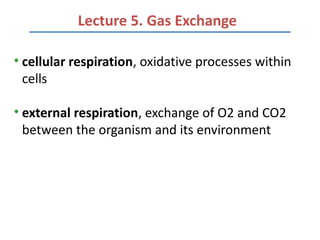Denunciar
Compartir
Descargar para leer sin conexión

Recomendados
Recomendados
Más contenido relacionado
La actualidad más candente
La actualidad más candente (20)
Destacado
Destacado (20)
Respiratory #1, Pulmonary Ventilation - Physiology

Respiratory #1, Pulmonary Ventilation - Physiology
Similar a Lecture 5 gas exchange
Similar a Lecture 5 gas exchange (20)
FN 513 SIMARPREET KAUR,RESPIRATION MECHANISM AND REGULATION.pptx

FN 513 SIMARPREET KAUR,RESPIRATION MECHANISM AND REGULATION.pptx
Breathing and Exchange of Gases.pptx is made for teaching class 11

Breathing and Exchange of Gases.pptx is made for teaching class 11
Más de Jonathan Chan
Más de Jonathan Chan (11)
Lecture 4 digestion and nutrition 2nd sem 2008-2009

Lecture 4 digestion and nutrition 2nd sem 2008-2009
Lecture 2 support and protection 2nd sem 2008-2009

Lecture 2 support and protection 2nd sem 2008-2009
Lecture 5 gas exchange
- 1. Lecture 5. Gas Exchange • cellular respiration, oxidative processes within cells • external respiration, exchange of O2 and CO2 between the organism and its environment
- 2. Gas Exchange Surfaces • for diffusion to be effective, gas-exchange regions must be: – moist – thin – relatively large • effectiveness of diffusion is enhanced by vascularization
- 3. Respiratory Organs • cutaneous respiration (direct diffusion)
- 4. Respiratory Organs • Tracheal systems (branching system of tubes)
- 5. Respiratory Organs • Gills or branchia (external or internal) papulae (dermal branchiae or skin gills)
- 6. Respiratory Organs • Gills or branchia (external or internal) gills in axolotl (Ambystoma mexicanum) branchial tufts (gills) in marine worm
- 7. Respiratory Organs • Gills or branchia (external or internal) parapodia in ragworm (Nereis spp.)
- 8. Respiratory Organs • Gills or branchia (external or internal)
- 9. How a fish ventilates its gills
- 10. countercurrent flow/exchange Copyright © 2002 Pearson Education, Inc., publishing as Benjamin Cummings
- 12. Respiratory Organs • Lungs (invaginations)
- 13. • Lungs of frogs A frog ventilates its lungs by positive pressure breathing.
- 14. • Lungs of mammals
- 15. • Lungs of mammals Mammals ventilate their lungs by negative pressure breathing.
- 16. • Lungs of birds http://www.peteducation.com/article.cfm?c=15+1829&aid=2721
- 17. • Lungs of birds http://www.peteducation.com/article.cfm?c=15+1829&aid=2721
- 18. • the volume of air an animal inhales and exhales with each breath is called tidal volume – it averages about 500 mL in resting humans • the maximum tidal volume during forced breathing is the vital capacity – about 3.4 L and 4.8 L for college-age females and males, respectively
- 19. • most animals transport most of the O2 bound to special proteins called respiratory pigments – hemocyanin – hemoglobin
- 20. • when the control center registers a slight drop in pH, it increases the depth and rate of breathing, and the excess CO2 is eliminated in exhaled air
- 21. • O2 diffuses into pulmonary capillaries • most O2 combines with hemoglobin in red blood cells to form oxyhemoglobin • CO2 diffuses out of pulmonary capillaries • most CO2 is transported in the form of bicarbonate ion • some CO2 combines with hemoglobin to form carbaminohemoglobin
- 22. Fig. 31.27
- 23. • cooperative oxygen binding and release is evident in the dissociation curve for hemoglobin
- 24. • a drop in pH lowers the affinity of hemoglobin for O2, an effect called the Bohr shift
